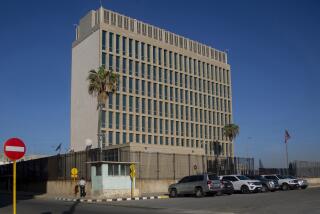Study Links Lou Gehrig’s Disease, Gulf War Service
- Share via
WASHINGTON — Americans who served in the Gulf War were nearly twice as likely to develop Lou Gehrig’s disease as other military personnel, the government reported Monday. It was the first time officials acknowledged a scientific link between service in the Gulf and a specific disease.
The Department of Veterans Affairs said it would immediately offer disability and survivor benefits to veterans with the disease who served in the Persian Gulf during the conflict a decade ago.
“The hazards of the modern-day battlefield are more than bullet wounds and saber cuts,” said Anthony J. Principi, secretary of Veterans Affairs.
The research, which included nearly 2.5 million military personnel, is one of the largest epidemiological studies ever conducted and offers the most conclusive evidence to date linking Gulf War veterans to any disease. Still, researchers don’t know why these veterans were more likely to get sick.
Veterans have long maintained that a variety of illnesses are associated with service in the Gulf, but scientific evidence has been scant and the Pentagon has resisted making the connection. Last year, the National Academy of Sciences was unable to link any of these complaints to a specific cause associated with military service.
“There was massive denial and obfuscation for years,” said Tom Donnelly of South Windsor, Conn., whose son Michael, an Air Force pilot in the Gulf War, is paralyzed with Lou Gehrig’s disease, also known as amyotrophic lateral sclerosis, or ALS.
The top health official at the Defense Department, Dr. Bill Winkenwerder Jr., said Monday that the conclusions are “not the study results we’d like to report.” He admitted that Pentagon officials have downplayed complaints about Gulf War illnesses in the past.
“There’s been a maturation of thinking about health risks associated with deployed military service,” said Winkenwerder, the assistant secretary of Defense for health affairs.
In October, a federally funded study suggested that children of Gulf War veterans are two to three times more likely than those of other vets to have birth defects, but defense officials questioned the research methodology and were skeptical of the results.
The results released Monday have not yet been reviewed by other scientists or published in an academic journal, and officials cautioned that they are preliminary. Officials said they were releasing the data now to prevent further delay in compensating victims of the progressive, fatal disease.
“They need help now and we will offer them that help,” Principi said.
To qualify for benefits after leaving the military, veterans must prove that their illnesses are related to military service. Principi said all those with Lou Gehrig’s disease who served in the Gulf War will be approved automatically.
About 5,000 Americans are diagnosed each year with Lou Gehrig’s disease, a fatal affliction of the nervous system whereby muscles stop receiving signals to operate. Victims’ bodies slowly shut down, losing their ability to move, to swallow and eventually to breathe, though their minds remain alert.
“I used to say if anybody called central casting and said, ‘Send up a fighter pilot,’ this is the guy they would send,” Donnelly said of his 6-foot-4 son. “Now he has wasted away to bones and skin.”
The study, funded by the Defense Department, compared nearly 700,000 military personnel who served in the Gulf War from August 1990 to July 1991 with another 1.8 million personnel who did not. It found that those who were deployed were nearly twice as likely to develop ALS.
Among Gulf War veterans, the rate of disease was 6.7 people per million. Among other military personnel, it was 3.5 per million.
Those who served in the Air Force were 2.7 times as likely to contract the disease, and those in the Army were twice as likely. But disease rates among Marine and Navy veterans were not statistically different from those who didn’t serve in the Gulf.
More to Read
Sign up for Essential California
The most important California stories and recommendations in your inbox every morning.
You may occasionally receive promotional content from the Los Angeles Times.










